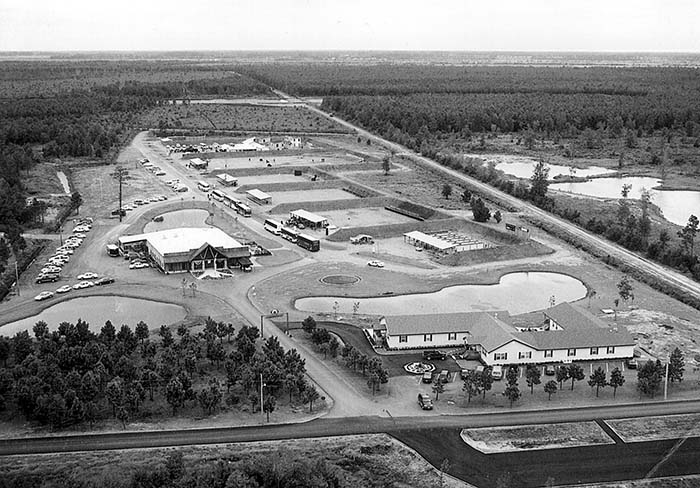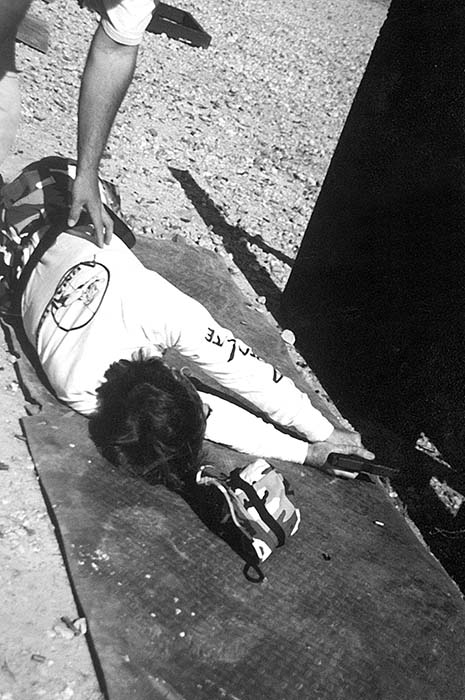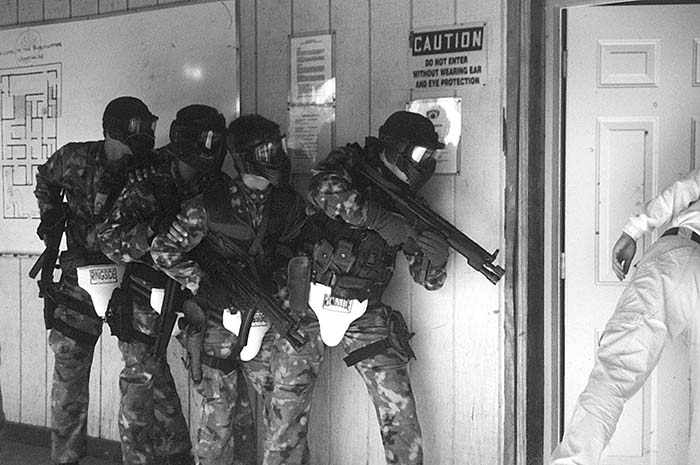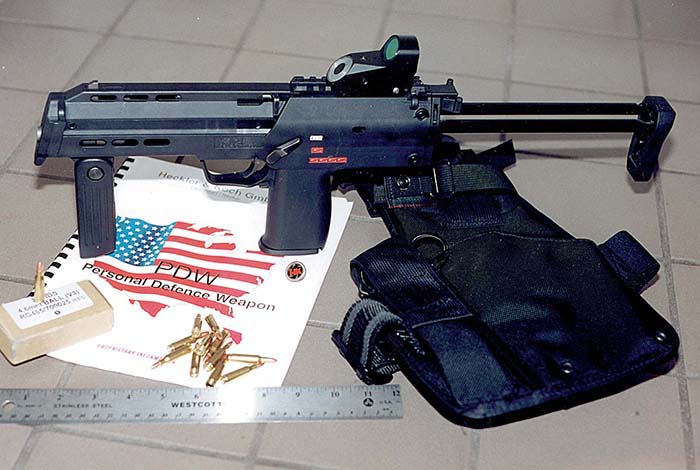NATO Special Operations team prepares for “Dynamic Entry”.Counter Terrorist Operation is one of two tactical live fire “Shoot Houses”.
By Charles Q. Cutshaw
There are many axioms regarding training, but probably the closest to reality is that the soldier, marine or police officer will fight as he has been trained. If training is unrealistic and highly structured, that is the way the individual will learn to fight – ultimately to his detriment and possible demise. There is no simple formula for training, but the best is that which is as realistic as possible and stressful without being so much so that the student fails to learn. Realistic and dynamic training is the key to operational success and military forces that water down their training to meet lowered standards to accommodate “gender norming” or those who cannot meet higher standards will ultimately suffer in the long run. Specialized national military training facilities are generally excellent, but there are only so many such facilities in existence and after conducting repeated training exercises through the same facilities, the student becomes accustomed to the facility, learns what to expect, and as a result his training suffers. It is for this and other reasons that a number of commercial training facilities have been established in the USA, some better than others. One of the best is Blackwater Training Center in Moyock, North Carolina, just south of the Virginia border near the Virginia Beach/Norfolk/Chesapeake metropolis.
If one or two words were to be used to describe Blackwater, they would be self-contained and flexible. In the paragraphs that follow we will demonstrate why this is so. Blackwater was designed and built by former military special operations personnel with a goal in mind of providing the best training possible to military personnel, law enforcement officers and qualified civilians. Every aspect of Blackwater was conceived and developed with this sole purpose in mind. Blackwater literally began with a “blank slate.” There were no existing facilities that required any compromises with the established goals. The land was purchased with a view in mind that all ranges and training would be on Blackwater-owned property. The training facility presently encompasses over 20 square kilometers (8 square miles) with potential for further growth to accommodate expanding training missions. In addition to ranges and urban training areas, Blackwater has a US Department of Defense approved parachute drop zone for airborne operations and man-made lakes that are sufficiently deep and wide for divers to conduct realistic amphibious training and “raids” on shore facilities. There is a helicopter landing pad and the facility can accommodate heliborne military operations, to include “fast roping” (rappelling). Blackwater also has a realistic mock urban training area, complete with a “high school.” The internal walls of many Blackwater buildings can be reconfigured to provide variety and additional training challenges. The overall city facility is designed for the use of Simunitions, but other facilities are set up for live ammunition training. There are two such tactical close quarters battle (CQB) live ammunition “shoot houses,” one single story, the other two stories.

Blackwater’s outdoor CQB range training facilities are varied and challenging. There are seven ranges, several of which are computerized with random target presentation in each student’s “shooting lane” so that training does not become repetitious and the challenge of engaging targets at different ranges and heights and with varied times for successful engagement is maintained. The student is forced to use his weapon in a variety of shooting positions from offhand through prone; using both strong and weak handed shooting positions. The reader will note that the class in which the author participated included several females, one of whom was the author’s wife, but the training standard was the same for all personnel of equal experience, both male and female. One accompanying photograph shows the author’s wife in a very low prone position being forced to engage difficult targets through a small ground-level aperture. During such episodes, the instructors provide an extra level of additional verbal stress to ensure that the student’s adrenaline level is maintained. Steel targets for ranges and the ranges themselves are constructed by Blackwater personnel. In fact, Blackwater recently established a secondary “spin off” branch called Blackwater Target Systems and now does a thriving business manufacturing and selling range target systems to other training facilities and ranges throughout the USA. Because it has its own in-house engineering and facilities manufacturing capabilities, if a unit scheduled for training desires special features for its training curriculum, the Blackwater engineering staff can expeditiously design and construct the facility modification or set of targets on very short notice.
A training facility is much more than the physical plant, however. While “shoot houses” and ranges where academic lessons are put to practical use comprise the core of the training experience, there are other important aspects, as well. To prepare the students for tactical training, Blackwater has two classrooms, each with seating for 50 students. Both classrooms are fully equipped with multimedia training aids, including TV/VCR, overhead projectors, slide projectors, chalkboards and other state of the art audiovisual training equipment. Another Blackwater feature not to be found elsewhere is on-site accommodations. There are four private hotel-like rooms, and while these are not equivalent to luxury hotel facilities, they are comfortable, clean, well-maintained and include cable TV, telephone, computer connection, private bath, air conditioning, private outside balcony and full housekeeping service. For tactical teams, the accommodations are somewhat more spartan, with barracks-type facilities to accommodate up to 68 persons. The lodge facility also has three lounges with recreation facilities, refrigerators and microwave ovens. Breakfast and lunch are provided each training day in Blackwater’s on-site dining facility. The meals are hearty home-style fare prepared by local cooks and the quality and quantity are both first class. Beverages are available all day. Blackwater is a fully licensed firearms facility and can receive and accommodate any type of small arm, whether individual or crew served, in its vault facility. There is a covered dedicated space for weapons maintenance where students can clean and maintain their firearms. If the student happens to forget, lose or break a piece of his or her gear, the Blackwater Pro Shop has a variety of weapons, accessories and equipment for sale at reasonable prices.
Staff personnel are also a critical element in any training environment and those at Blackwater have been chosen not only for their background – all are former military and most were special operations personnel – but for their ability to relate to students and achieve training goals, as well. Potential Blackwater instructors are evaluated by the organization’s staff prior to ever conducting a class and are probationary until they have proven their ability as instructors. Although highly desirable, merely having military or special warfare experience is only the first step towards to achieving instructor status at Blackwater. All CQB classes are taught by former special warfare personnel or seasoned SWAT officers. The Blackwater sniper and precision rifle training, however, is conducted by LtCol Norm Chandler, USMC (ret), an internationally recognized authority on the subject and one of the world’s premier manufacturers of precision rifles.
SAR recently participated in one of Blackwater’s tactical pistol courses, which is a prerequisite for civilians prior to participation in any other Blackwater training course. Both the author and his wife participated in the course to obtain differing viewpoints of the training. We should note that the author and his wife are both graduates of other nationally recognized firearm training facilities and both are nationally certified and experienced firearm instructors. The author is also a former army infantry, ordnance ammunition and technical intelligence officer and a Vietnam veteran. We believe that we are thus well qualified to evaluate the quality of training in which we participated.

Our class was small and consisted of a number of individuals, both men and women, whose experience with firearms varied from none whatsoever to one individual who was qualified as an international pistol master. Such a diverse class is a true challenge to the instructor, who must not only relate to persons who had rarely fired a handgun, but at the same time challenge an individual who was probably his equal in mastery of the pistol. At the same time the Blackwater instructor had to relate to and challenge a variety of other men and women whose experience levels ran from basic to expert. The instructor wisely began by assessing the experience levels of the class and then modified the training curriculum to meet the class’ individual and collective requirements. Without entering into detail, a post-course poll of students revealed that all felt that the training was superb. Beginners learned safe handling and basic tactical use of the handgun, while more experienced individuals were able to enhance their abilities through new training challenges. These challenges, coupled with individual attention from the instructor, resulted in a truly outstanding training experience for all.
While at Blackwater, we had the opportunity to observe other training classes in progress. As mentioned, there was a sniping class underway and we were surprised to find two NATO special operations snipers participating, along with some American military colleagues and a few police snipers. We were even more surprised to observe a NATO special operations team (see Photo top right of page 57.) conducting counterterrorism, dynamic entry and building clearing tactics under the supervision of US special warfare personnel. We were given permission to photograph the team and mention these facts on the condition that we did not divulge the nationality of the nation whose men were undergoing training at Blackwater, nor the American unit helping them. We also had to wait until the team member’s faces were covered by their gas masks. (Special operations personnel are virtually all reluctant to be photographed.) Suffice it to say that both US and foreign special operations forces regularly use Blackwater for training.
Blackwater offers training in many more disciplines than those mentioned herein. Courses are also offered in tactical shotgun, carbine, submachine gun, hostage rescue, high-risk warrant service, executive protection and driving and competition pistol and rifle. Courses can also be tailored to the needs of a specific organization upon request. All courses include on-site lodging and two meals per day.
In sum, we found the Blackwater training experience to be challenging, dynamic and for those reasons alone, rewarding and enjoyable. The quality of training alone is sufficient reason for the facility to merit close consideration by any individual, military organization or law enforcement agency wishing to experience challenging, dynamic and realistic training. The outstanding on-site training facilities that can accommodate virtually any type of training are another positive feature. Blackwater’s personnel are all professional, proficient and cheerfully helpful. These attributes, coupled with on-site accommodations and meals combine in a synergy that frees the student from concerning himself with anything other than achieving his training objectives during his stay at Blackwater. Once the individual or team arrives, virtually every personal requirement may be obtained on-site. This optimizes the individual and team training experience because time that would otherwise be spent on administrative matters is unnecessary, unlike other facilities where lodging and meals are off-site, requiring extra time for meals and travel. Because of these unique features, we believe that Blackwater presently offers what is arguably the premier commercial training facility in the United States.
Blackwater Training Center
850 Puddin Ridge Road
Moyock, NC 27958
(252)435-2488 Phone
(252)435-6388 – Fax
| This article first appeared in Small Arms Review V3N12 (September 2000) |












